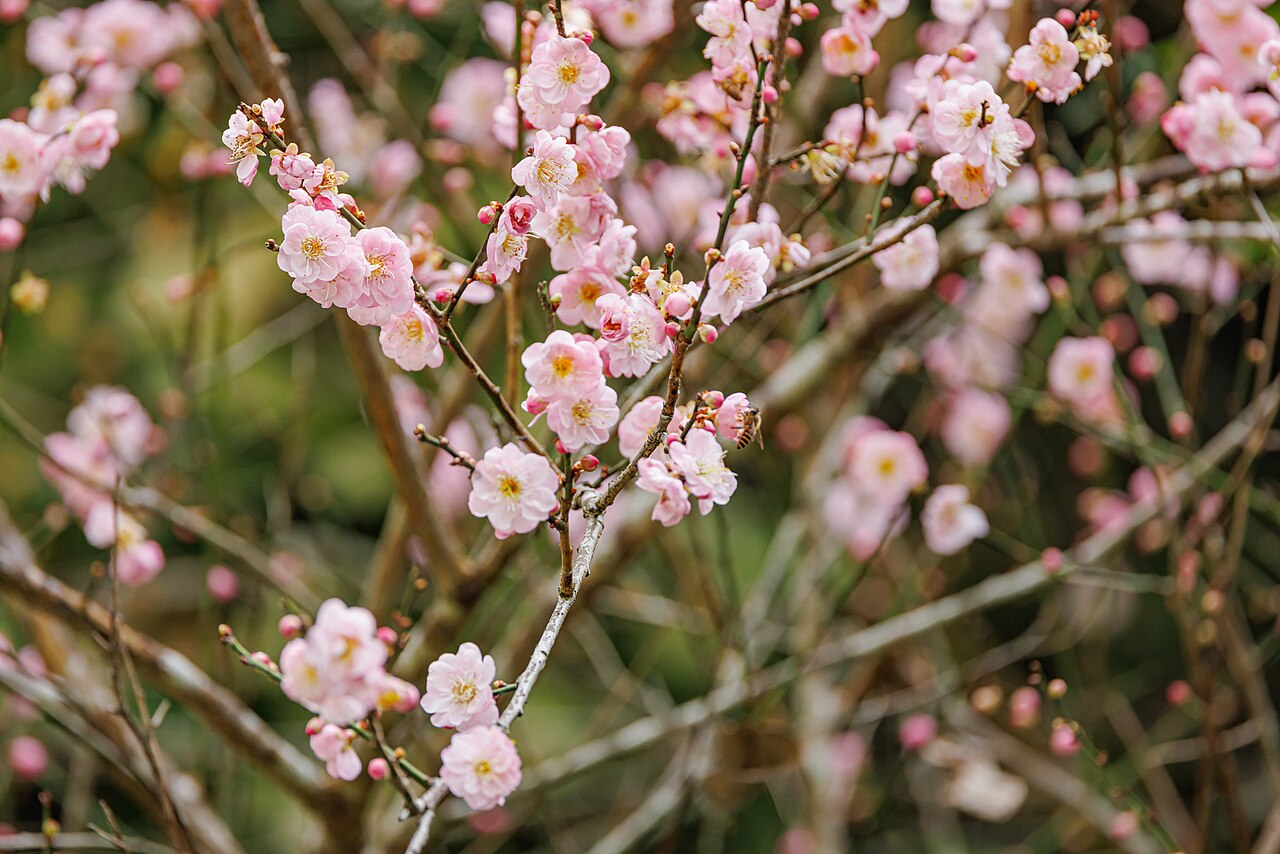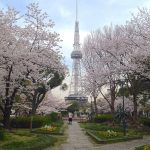The ume is a significant tree species known as “Prunus mume,” which is not only a component of “umeshu,” the famous Japanese liqueur made from unripe and green ume fruits, but it is also highly valued for its cultural, aesthetic, and culinary importance. The tree produces a delicious fruit, usually called a plum, but it is closer to an apricot in taste and texture. The fruit is used in various dishes, including pickles, jams, desserts, and liqueurs, and is an essential ingredient in many Japanese cuisines. In Japan, the ume flavor is available in candies, juices, alcohol, and sauces and is highly regarded for its unique taste and aroma.
Besides its culinary uses, the ume tree is famous for its beautiful plum blossoms. Plum blossom viewing is called “umemi” in Japan, a popular cultural tradition dating back to the Nara period (710-794). The pink, red, and white flowers have a strong, sweet scent and are loved by Japanese people. Plum blossoms symbolize purity, perseverance, and renewal and signify good luck and fortune.
The peak period for viewing the blossoms depends on the variety of trees, but it usually ranges from early February until late March. Many locations hold festivals during peak periods, so catching that will be well worth the trip! Plum blossom viewing is not as widely known as cherry blossom viewing but is just as stunning and worth experiencing. Some of the best places to view plum blossoms in Nagoya include the Nagoya Agricultural Center, Tsurumai Park, Nagoya Castle, and Meijo Park. These places offer breathtaking views of the blossoms and various cultural and entertainment activities, making them perfect destinations for tourists and locals.
Umemi (Plum Blossom Viewing) Spots in Nagoya
If you want to see beautiful plum blossoms this winter, here are some locations you can visit.
Higashiyama Zoo and Botanical Gardens
Suppose you are seeking a place to witness the mesmerizing beauty of plum blossoms known as umemi in Nagoya and right at hand. In that case, the Higashiyama Zoo and Botanical Gardens are a perfect destination for you. Located near Higashiyama Koen Station on the Yellow Line, it offers a convenient option to explore the stunning blossoms. The gardens are a visual delight with 200 trees in 30 different varieties; the plums bloom from mid-February to early March. While you stroll through the gardens, you can witness the beautiful blossoms of the cherry trees, plum trees, and apricot trees. So, if you want to experience the captivating beauty of umemi, this is the perfect place to visit.
3-70 Higashiyama Motomachi, Chikusa Ward, Nagoya (google map)
052-782-2111
Higashiyama Zoo and Botanical Gardens
Nagoya Castle (and Meijo Park)
Nagoya Castle is an impressive symbol of Nagoya, a classic landmark of immense historical significance. The castle was originally built in 1612 by Tokugawa Ieyasu, one of Nagoya’s most renowned and famous residents. However, it was unfortunately destroyed during a war and had to be rebuilt. The castle’s surrounding grounds, which include Meijo-Koen Park, are breathtaking and offer many exciting things to see and explore.
One of the park’s main highlights is the various gardens surrounding the castle. Although the castle grounds have only 100 trees of 13 different varieties, they are carefully tended to create a serene atmosphere ideal for visitors to enjoy the beauty of plum blossoms. The best time to visit the castle is from the middle of February to early March, when the plum blossoms are in full bloom, delighting visitors with their delightful pink and white hues.
1-1 Honmaru, Naka Ward, Nagoya (google map)
052-231-1700
www.nagoyajo.city.nagoya.jp
Nagoya Agriculture Center
The Nagoya Agriculture Center is located in the heart of Tenpaku Ward and is a paradise for nature lovers. The center offers a range of activities for visitors to explore and enjoy. You can savor the aroma of freshly brewed coffee and taste healthy, organic vegetables from the cafes and shops. The greenhouses and model farms, with their livestock, offer an excellent opportunity to get up close and personal with nature.
The sprawling lawns and serene atmosphere make the center a perfect spot for a picnic. However, be prepared for the crowds during the blossom season. The center has an impressive collection of 800 trees of 12 varieties, including beautiful and unique hanging types.
Visiting from mid-February to early March is highly recommended to witness the breathtaking beauty of the cherry blossoms. The vibrant pink and white flowers against the backdrop of the clear blue sky make for a stunning sight. So, pack your bags, grab your camera, and get ready to immerse yourself in the beauty of the Nagoya Agriculture Center.
2872-3 tenpaku cho oozawa hirabari kuroi, Tenpaku Ward, Nagoya (google map)
052-801-5221
www.city.nagoya.jp
Mt Togoku (Togokusan) Fruit Park
Togokusan Fruit Park is a captivating agricultural park that promises to be a treat for nature enthusiasts and fruit lovers. It boasts 15 different orchards, which showcase an impressive array of local and exotic fruits grown with utmost care and dedication.
Apart from the orchards, the park also features a serene fishing area, a breathtaking Japanese garden, and vast fields brimming with seasonal flowers and plants. Visitors can take in the beauty of nature and learn more about agriculture and outdoor education in this beautiful park.
Moreover, the park also offers a wide range of restaurants and shops, where visitors can indulge in some delicious local cuisine and purchase souvenirs.
With 200 trees of 21 different varieties, the park offers a delightful spectacle of blossoms from January to March. However, the ideal time to visit is mid-February to early March when the blooms peak.
Togokusan Fruit Park is a must-visit destination that offers an unforgettable experience for all its visitors.
2110 Togoku, Kamishidami, Moriyama-Ku, Nagoya (google map)
052-736-3344
www.fruitpark.org
Sori Green Park (Souri Green & Flower Fureai Park)
Chita City in Aichi Prefecture, known for having the region’s most prominent plum grove, holds a significant place in Japan’s cultural and natural heritage. The Sōburi area, once renowned for its delicate pink blossoms, attracted numerous visitors for plum viewing. However, the Ise Bay Typhoon in 1959 caused substantial damage to the grove, and further loss occurred due to the construction of the Sōburi Pond as part of the Aichi Canal project, which led to the submergence of many trees. Consequently, only a small portion of Sōburi’s plum trees survived.
In the years that followed, the grove was revitalized through the efforts of local residents and the prefectural government. New saplings were planted, leading to a remarkable recovery. Today, the grove boasts about 6,000 plum trees comprising 25 different varieties. The best time to view these blossoms is from mid-February to mid-March. Visitors can enjoy various types of plum trees, including the light pink Sōburi plum, the white, single-petaled Shirokaga, and the Aoshaku, characterized by its green branches and bluish-tinged white flowers.
The “Sōburi plum” itself has a unique history. At the beginning of the Meiji era, a person named Kamezō Wanibe propagated the variety by grafting it onto peach rootstocks. This variety is known for its thick flesh and small pit, making it particularly suitable for making umeboshi (pickled plums). Additionally, on October 10, 2019, the Sōburi plum was designated as a natural monument by Chita City, recognizing its cultural and historical significance.
During this time, you can witness a matsuri (festival) held here, featuring stage events, music performances, and traditional outdoor tea ceremonies held under the blossoms. This park is a must-visit destination for anyone who loves nature and wants to escape city life’s hustle and bustle.
Soburi Pond Plum Festival
Access via Asakura Station on Meitetsu Tokoname Line from Nagoya or Kanayama Station, then take the Chita Bus bound for Sohri. Get off at Ume-no-yakata-guchi. Walk east!
2024/2/10 to 3/10/2024
3-101 Sohridai, Chita-shi, Aichi 478-0018 (google map)
05-62-54-2911
梅まつり | 【公式】佐布里池 梅まつり (chita-kanko.com)
Dinkun Chen, CC BY-SA 4.0, via Wikimedia Commons




